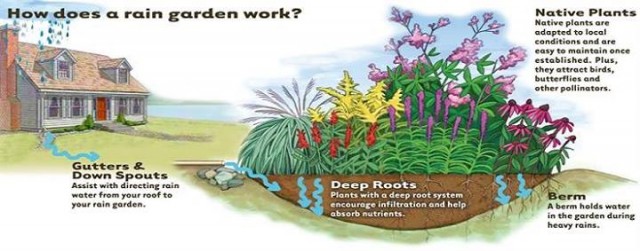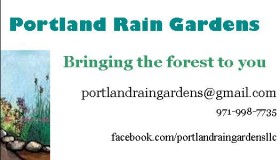
To me, weedists are so much more than connoisseurs of fine cannabis. We are also intelligent, caring earth-conscious people with a high level of creativity. With that in mind, I give you the rain garden.
Rain gardens are not limited to the rainy Northwest. As I researched this article, I found similar information available across the country. These earth-saving gardens are relatively easy to install and require little to no maintenance to do their magic.
Here’s what a rain garden is all about according to the Rain Garden Network:
“A rain garden is a shallow, constructed depression that is planted with deep-rooted native plants & grasses. It is located in your landscape to receive runoff from hard surfaces such as a roof, a sidewalk and a driveway. Rain gardens slow down the rush of water from these hard surfaces, holds the water for a short period of time and allows it to naturally infiltrate into the ground.
A rain garden can be thought of as a personal water quality system because it filters the runoff from your roof and lawn and recharges the groundwater.”
Here’s why you may want to have one, also from the Rain Garden Network:
“A Rain Garden will:
- Filter runoff pollution
- Recharge local groundwater
- Conserve water
- Improve water quality
- Protect rivers and streams
- Remove standing water in your yard
- Reduce mosquito breeding
- Increase beneficial insects that eliminate pest insects
- Reduce potential of home flooding
- Create habitat for birds & butterflies
According to raingardens.org, rainwater becomes polluted as it runs off our roofs, parking lots, streets and lawns. Since it is entering our streams and waterways through storm drains instead of through the earth, these pollutants are not filtered out. Also, since storm water can be warm, it contains less oxygen than cooler water, which can be big trouble for sensitive creatures, like trout. They can’t survive with fluctuating water temperatures and the lower oxygen levels found in warm water.
Ground water is naturally filtered by the earth and is released slowly back into the ground. Fast-running storm water can cause erosion, flooding, habitat destruction and more. Incorporating a rain garden into your landscape can help restore this natural process. In some cities, like Portland, Oregon, a rain garden can eliminate the need to rely on your municipality’s storm drain system. The Portland Water Bureau pays a cash incentive to home owners who disconnect from this service. This may be true for your area, too.
Storm water specialists in Maryland created the first rain gardens in the 1990’s. Rain gardens were invented as a way of imitating the function of natural filtering systems that development removed. The introduction of plants to the system was a new idea for stormwater engineers. Prior to this, infiltration and stored stormwater ponds were in use, but not as successful in filtration – think Erin Brockovich and those nasty holding ponds.
 The first rain garden I ever saw was at a friend’s house here in Portland. It was donated by Portland Rain Gardens as a silent auction prize at a fund raiser. Some of the pictures here are from that garden. Syd Rappaport and Brian Wilson are a Portland, Oregon couple whose adventure into rain gardening started with their own yard and a strong desire to create a greener lifestyle.
The first rain garden I ever saw was at a friend’s house here in Portland. It was donated by Portland Rain Gardens as a silent auction prize at a fund raiser. Some of the pictures here are from that garden. Syd Rappaport and Brian Wilson are a Portland, Oregon couple whose adventure into rain gardening started with their own yard and a strong desire to create a greener lifestyle.
I would suggest at least one consultation with a pro like Portland Rain Gardens to figure out the best place to put your garden. The location can make a big difference in functionality. It is important to check with your local officials to make sure you can collect water in your area. Places with little to no rain may not allow it.
Most states have laws that protect natural habitats. which means you can’t just go out and dig up the indigenous plants that your garden requires without a permit. If you are doing this project on your own, you will need to get those permits to avoid fines and penalties. The company you choose to hire should have those permits in place, too.
Here in Oregon, the Columbia Land Trust’s Backyard Habitat Certification Program provides a way to get technical support to help manage storm water and to assist property owners through three levels of advanced habitat restoration. The program provides discounts on tools and native plants along with other special benefits. The biggest benefit of all is the knowledge that you are decreasing your carbon footprint and enhancing the wildlife and environment right in your yard.
For Portlanders, I would definitely suggest investing the help of Portland Rain Gardens. But, if you are not fortunate enough to live in the Portland area, you can check with your local cooperative extension service to find out more about rain gardens. Google also provides a wealth of information no matter where you live. Rain gardens are a beautiful way to help the environment – a good thing for all of us!










